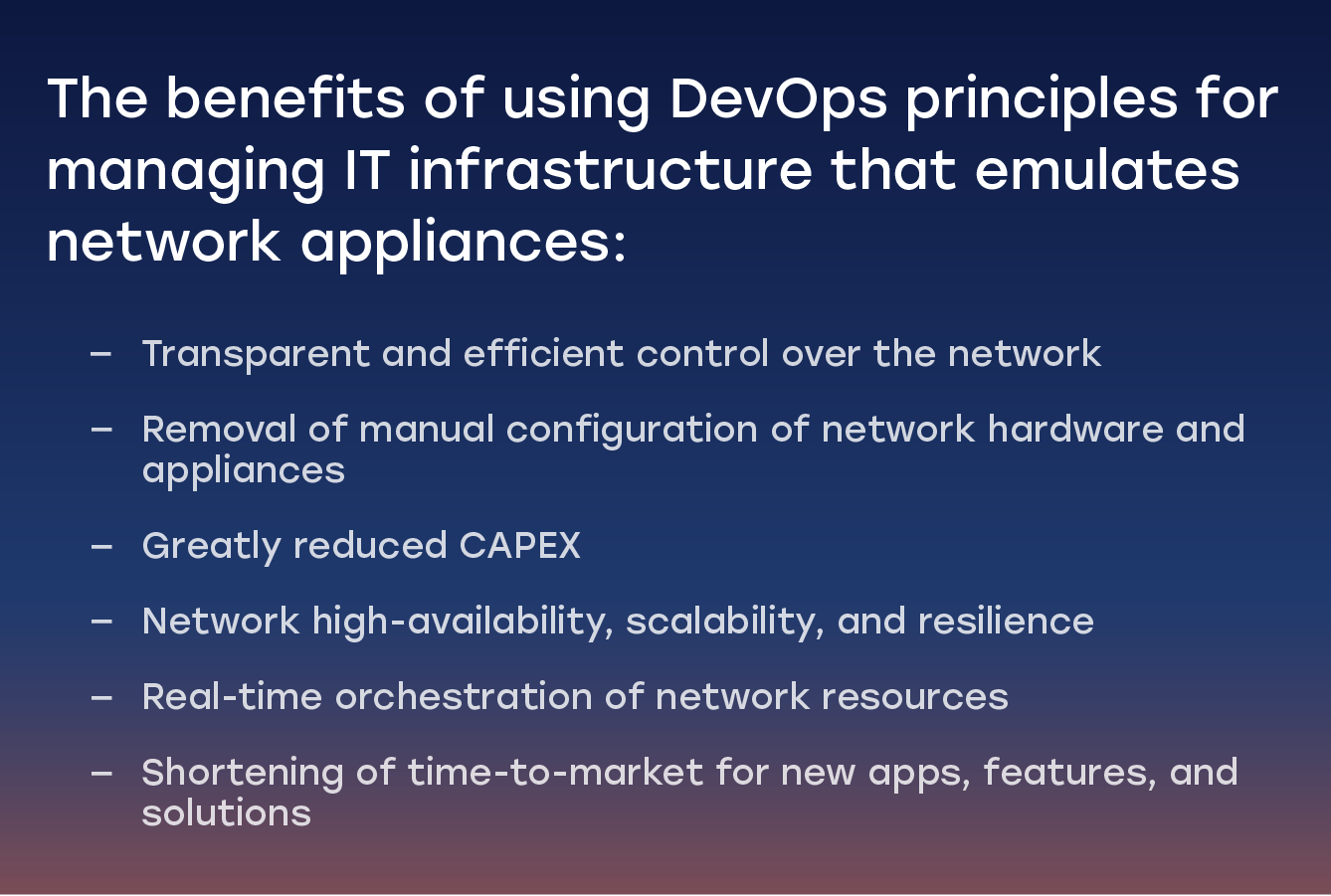Benefits of adopting DevOps in the telecom industry
DevOps is a mindset and culture of software delivery and IT operations based on Agile methodology and principles that revolutionized the way we develop software 10 years ago. Nowadays, there are multiple benefits of adopting DevOps in the telecom industry, especially in terms of building 5G networks. We explain these below.
Traditional telecom networks are composed of specialized hardware that is built according to rigid specifications. Once the technology improves, the old equipment becomes obsolete and has to be replaced with the network hardware of new generation. This has happened 4 times already, thus the coming generation of telecommunication equipment is called 5G — and it is totally different from the generations that came before.
Instead of being designed and manufactured according to rigid specifications to form preconfigured systems, 5G networks will be based on software and run atop standard commodity hardware. This will allow providing high bandwidth, low latency and ease of configurability for multiple use cases:
- IoT networks, Industry 4.0 and edge computing
- Smart cities and traffic control
- Artificial Intelligence platforms
- Augmented Reality / Virtual Reality and 3D video
- Self-driving cars and smart highways and railroads, etc.
In addition, 5G is a welcomed leap up for mobile connectivity and Internet access worldwide. Naturally, these use cases differ immensely, and the infrastructure must be able to support a huge variety of requirements, providing resilience and ease of configuration. Implementing all of this through hardware is impossible, so software delivery principles come into play.
5G is built around three main principles SDN, NFV, and VNF.
- SDN stands for Software-Defined Networking, meaning all configuration is delivered through virtualized software, so it is centrally controllable and easily adjustable.
- NFV stands for Network Functions Virtualization, meaning that instead of specialized hardware and appliances, these functions are performed with containerized apps deployed to Docker containers
- VNF stands for Virtual Network Functions, meaning that the required NFV can be launched quickly, as it is a simple software deployment to commodity hardware.
Thus said, the era of heavily investing in manufacturing, installment, and configuration of immense networks of hardware appliances is over. All the telecom operators have to do is renting public cloud computing resources and install the edge computing nodes where needed, which then connect to their main servers in the cloud. This provides unlimited capabilities to quickly deploy and configure the required infrastructure — and here is where the DevOps comes to the table.
Applications of DevOps in the telecom sector
Utilizing DevOps principles to manage the IT infrastructure composed of containers with NFV applications emulating the network appliances provides the following benefits:
- transparent and efficient control over the network
- removal of manual configuration of network hardware and appliances
- Greatly reduced CAPEX
- Network high-availability, scalability, and resilience
- Real-time orchestration of network resources
- Shortening of time-to-market for new apps, features, and solutions
Containerizing will be great for essential features like firewall functionality, CDN (Content Delivery Network), Network Address Translation mechanism (NAT), traffic routing, and even broadband remote server address (BRAS) modules. All of these can be codified and packed into neat little code containers that can be easily managed through 3 main DevOps principles — IaC, CI and CD.
- IaC or Infrastructure as Code — an approach to IT infrastructure orchestration, where each required infrastructure is described with declarative language in textual files, so-called “manifests”. These manifests are processed by infrastructure orchestration and configuration management platforms like Terraform and Kubernetes, which allow designing, implementing and running the infrastructure with ease.This approach ensures the uniformity of environment configurations across the software delivery process, minimizing the time-to-market for new product features, and helps minimize the numbers of code bugs due to the lack of configuration drift. Any environment settings can be versioned and stored in GitHub like any other code.This way, it can be provisioned, managed, adjusted, and deleted in seconds, instead of time-consuming repairs and reconfiguration after failures. Not to mention the failures like release crashes happen far less often, and recovery from them is nowhere as hard as it used to be.
- CI or Continuous Integration. This means that all code and configuration updates are done in smaller chunks, rather than in larger batches. This ensures the code is cleaner, there are less integration bugs, the time-to-market of new products is much shorter and updates to your Virtual Network Functions (VNFs) are delivered on a predictable and reliable schedule. This is ensured through the use of the tools like Gitlab CI, Circle CI, Jenkins and other.
- CD or Continuous Delivery. This is the approach to automating as many repetitive, labor-intensive and error-prone IT infrastructure management operations, as possible. Thus said, when the CD pipeline is configured correctly, your IT department can concentrate on actually improving your business efficiency, instead of doing the same tedious configuration tasks again and again. The software delivery life cycle is much more predictable and manageable this way.
DevOps benefits for 5G telecom operators
As we mentioned before, the VNFs are software emulations of hardware appliances forming the network. Using such virtualized apps allows composing multifacet infrastructures with modules provided by various vendors, sometimes having multitenancy and interoperability issues. The more the variety of VNFs, the more the complexity of the NFV systems, obviously. This is how adopting DevOps in the telecom industry can help operations and development:
- Each VNF can be containerized to run in a Docker container atop a Kubernetes cluster. This ensures improved interoperability and simplifies multitenancy, as the hardware resources needed to support such a system are greatly lower, as compared to classical networks.
- Each system function can be separated into a microservice, effectively turning a maze of interdependencies to streamlined workflows with the exchange of messages between components through the APIs.
- Terraform and Kubernetes clusters have built-in options for monitoring and simple orchestration of containers with VNFs
- The modular structure ensures interoperability and portability to various NFV environments, so you can use the same building blocks to compose any telecom network your current project needs — virtually and very quickly.
- A service mesh is a layer of Kubernetes clusters that can be operated as a whole using Helm charts and other tools, further simplifying the management of the entire service for enterprise telecom operations managers
- Cloud-native deployment of such networks under DevOps model enables simple integration of Big Data analytics, which can be used to 2 major ends: both enabling automated infrastructure management under the AI overseer (autoscaling up and down based on workloads, automatic backups, seamless updates and releases, etc), and in-depth analysis of your workflows and machine-generated logs using ELK stack, Sumologic, Splunk, Prometheus and Grafana and other tools alike.
The transition to DevOps model of telecom product development is best demonstrated through the skyrocketing popularity of the web and mobile interfaces for accessing and managing all kinds of telecom networks and equipment, not to mention the browser-based services that run on this infrastructure. This would have not been possible without the transition from Waterfall to Agile methodology of software delivery life cycle.
However, the workloads and the competition are only going to increase, as the telecom industry is expected to provide stable 5G coverage not only in developed countries but for 2 more billions of mobile users in Indonesia and South America, who are expected to go online during the next 5 years, as stated in a report from PWC, a world-known business analyst and publisher agency.
Conclusions on the perspectives of DevOps in the telecom sector
Nearly $57 billion USD as revenue from mobile technology implementation is expected to be the award for the best mobile coverage provided by the telecom operators. Thus said, efficient DevOps implementation in the telecom sector is the question of gaining a competitive advantage and securing a leading market position in the years to come.
Most importantly, the existing 4G hardware and infrastructure can be used for provisioning the 5G coverage, so there is no need in huge CAPEX on hardware updates. The only requirement is to update the networks properly, utilizing the DevOps benefits to the fullest extent.
How to do it then? Obviously, if the telecom operator lacks the required DevOps expertise, the most obvious solution is outsourcing the project to one of the top 10 reputable Managed Services Providers worldwide, who are able to lend their services to help your company transform and future-proof it for 5G.
Should you like to do it on your own — IT Svit wishes you all the best and sincerely hopes you succeed. Should you decide to wait a bit more — no problem with that either, your more tech-savvy competitors will prevail. After all, as the famous W. Edwards.Deming quote goes, “It is not necessary to change. Your company survival is not mandatory”


